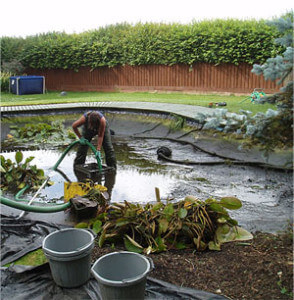Opening Your Pond in Spring
Article Courtesy of Mayer's Pet Shop, February 2012

Spring is here, and that means it’s time to start thinking about opening your pond for another season. Here are a few tips to help you get your pond in top shape.
Opening Your Pond: Cleaning

In ponds containing fish, it is not recommended to drain the pond completely. Use a large, long handled net to remove as much of the debris from the bottom as possible. Try not to stir the pond up too much or handle the fish as this can stress them, they are quite vulnerable early in the spring after a long winter of dormancy. It is best to wait until the water temperature reaches 60° before attempting to clean to allow the fishes’ immune system to become active again. It is also a good idea to perform a partial water change, approximately 25% of the pond volume.
Once the cleaning is completed, it is time to install the pump and filter. Your pump should match the size of the pond, meaning, it should pump the volume of your pond every 1-2 hours to provide adequate circulation and aeration. If you are keeping goldfish or koi, a biofilter is essential to maintain good water quality. Bigger is always better when it comes to pumps and filters. Larger filters require less cleaning for you, and healthier water for the fish. Spring is the time to start seeding your biological filter with beneficial bacteria, these are available in powder or liquid form and will kick-start your filter and help improve water quality greatly. Regular additions of these bacteria will also help to break down sludge and organic matter in the pond.
Remove marginal plants and water lilies and clean them up by removing all of the dead growth, and if necessary dividing and re-potting them. This is also a great time to fertilize plants with a slow release aquatic plant food tablet to give them a boost heading into the growing season. This should be done as quickly as possible in a shady area to prevent plants from drying out too quickly. Once the plants are cleaned and fertilized, place them back into the pond, and refill the pond. Remember, it is very important to use a de-chlorinator and chloramine remover any time you add water to the pond, unless you are on well water.
article courtesy of Mayer’s Pet Shop

Leave a Reply
You must be logged in to post a comment.